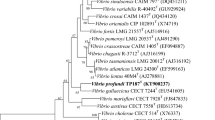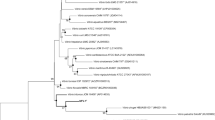Abstract
A novel Gram-stain-negative, facultative anaerobic, motile bacterium, designated as 404T, was isolated from a marine sediment sample in the Bohai Gulf, China. Growth was observed at 10–35 °C (optimum, 20–25 °C) and in the presence of 1.0–6.0% (w/v) NaCl (optimum, 1.0–3.0%). Phylogenetic analysis based on 16S rRNA gene sequences indicated that the strain 404T belonged to the genus Vibrio, showing the highest sequence similarity to Vibrio renipiscarius KCTC 42287T (97.6%). The draft genome is 4.5 Mb in length, containing 4278 protein-coding genes, 60 tRNA genes and 9 rRNA genes, and DNA G+C content is 44.1 mol%. Strain 404T contains phosphatidylglycerol, phosphatidylethanolamine, diphosphatidylglycerol, phosphatidylcholine, and phospholipid as the main polar lipids, and the predominant quinone is ubiquinone Q-8. The major cellular fatty acids (>8.0%) are C16 : 1ω6c and/or C16 : 1ω7c, C16 : 0, C18 : 1ω6c and/or C18 : 1ω7c. Strain 404T shows some typical characteristics among the members of genus Vibrio, while it can be clearly distinguished from the closely related type strains through genome analysis (average nucleotide identity and digital DNA–DNA hybridization values), fatty acid composition and a series of physiological and biochemical characteristics. On the basis of the polyphasic analysis, strain 404T is considered to represent a novel species of the genus Vibrio, for which the name Vibrio marinisediminis sp. nov., is proposed. The type strain is 404T (= MCCC 1H00367T = KCTC 62958T).

Similar content being viewed by others
References
Baumann P, Baumann L (1984) Genus II. Photobacterium Beijerinck 1889, 401AL. In: Krieg NR, Holt JG (eds) Bergey’s manual of systematic bacteriology, vol 1. Williams & Wilkins, Baltimore, pp 539–545
Parte AC (2018) LPSN—list of prokaryotic names with standing in nomenclature (bacterio.net), 20 years on. Int J Syst Evol Microbiol 68:1825–1829
Baumann P, Furniss AL, Lee JV (1984) Genus I. Vibrio Pacini 1854. In: Krieg NR, Holt JG (eds) Bergey’s manual of systematic bacteriology. Williams & Wilkins, Baltimore, pp 518–538
Dong XZ, Cai MY (eds) (2001) Chapter 14. Determination of biochemical characteristics. In: Manual for the systematic identification of general bacteria. Science Press, Beijing, pp 370–398
Ji X, Zhang C, Zhang X, Xu Z, Ding Y et al (2018) Pelagivirga sediminicola gen. nov., sp. nov. isolated from the Bohai Sea. Int J Syst Evol Microbiol 68:3494–3499
Kim OS, Cho YJ, Lee K, Yoon SH, Kim M et al (2012) Introducing EzTaxon-e: a prokaryotic 16S rRNA gene sequence database with phylotypes that represent uncultured species. Int J Syst Evol Microbial 62:716–721
Saitou N, Nei M (1987) The neighbor-joining method: a new method for reconstructing phylogenetic trees. Mol Biol Evol 4:406–425
Felsenstein J (1981) Evolutionary trees from DNA sequences: a maximum likelihood approach. J Mol Evol 17:368–376
Tamura K, Peterson D, Peterson N, Stecher G, Nei M et al (2011) MEGA5: molecular evolutionary genetics analysis using maximum likelihood, evolutionary distance, and maximum parsimony methods. Mol Biol Evol 28:2731–2739
Felsenstein J (1985) Confidence limits on phylogenies: an approach using the bootstrap. Evolution 39:783–791
Meier-Kolthoff JP, Auch AF, Klenk HP, Göker M (2013) Genome sequence-based species delimitation with confidence intervals and improved distance functions. BMC Bioinform 14:60
Sasser M (1990) Identification of bacteria by gas chromatography of cellular fatty acids. MIDI Technical Note 101
Komagata K, Suzuki KI (1988) Lipid and cell-wall analysis in bacterial systematics. Methods Microbiol 19:161–207
Minnikin DE, O’Donnell AG, Goodfellow M, Alderson G, Athalye M et al (1984) An integrated procedure for the extraction of bacterial isoprenoid quinones and polar lipids. J Microbiol Methods 2:233–241
Tarazona E, Ruvira MA, Lucena T, Macián MC, Arahal DR et al (2015) Vibrio renipiscarius sp. nov., isolated from cultured gilthead sea bream (Sparus aurata). Int J Syst Evol Microbiol 65(6):1941–1945
Cerdà-Cuéllar M, Rosselló-Mora RA, Lalucat J, Jofre J, Blanch A (1997) Vibrio scophthalmi sp. nov., a new species from turbot (Scophthalmus maximus). Int J Syst Bacteriol 47(1):58–61
Borrego JJ, Castro D, Luque A, Paillard C, Meas P et al (1996) Vibrio tapetis sp. nov., the causative agent of the brown ring disease affecting cultured clams. Int J Syst Bacteriol 46:480–484
Levican A, Lasa A, Irgang R, Romalde JL, Poblete-Morales M et al (2017) Isolation of Vibrio tapetis from two native fish species (Genypterus chilensis and Paralichthys adspersus) reared in Chile and description of Vibrio tapetis subsp. quintayensis subsp. nov. Int J Syst Evol Microbiol 67(3):716–723
Richter M, Rosselló-Móra R (2009) Shifting the genomic gold standard for the prokaryotic species definition. Proc Natl Acad Sci USA 106:19126–19131
Acknowledgements
We sincerely thank Prof. Aharon Oren in Hebrew University of Jerusalem for advice on nomenclature. This work was supported by the National Natural Science Foundation of China (81702054, 81501718) and Natural Science Foundation of Shandong Province (ZR2017BC011).
Author information
Authors and Affiliations
Corresponding authors
Ethics declarations
Conflict of interest
The authors declare that they have no conflict of interest.
Ethical Approval
This article does not contain any studies with human participants or animals.
Additional information
Publisher's Note
Springer Nature remains neutral with regard to jurisdictional claims in published maps and institutional affiliations.
The GenBank accession numbers of Vibrio marinisediminis 404T are MK347066 (16S rRNA gene) and JACFYF000000000 (draft genome), respectively.
Electronic supplementary material
Below is the link to the electronic supplementary material.
Rights and permissions
About this article
Cite this article
Zhao, H., Shan, J., Wang, T. et al. Vibrio marinisediminis sp. nov., Isolated from Marine Sediment. Curr Microbiol 78, 810–815 (2021). https://doi.org/10.1007/s00284-020-02290-y
Received:
Accepted:
Published:
Issue Date:
DOI: https://doi.org/10.1007/s00284-020-02290-y




